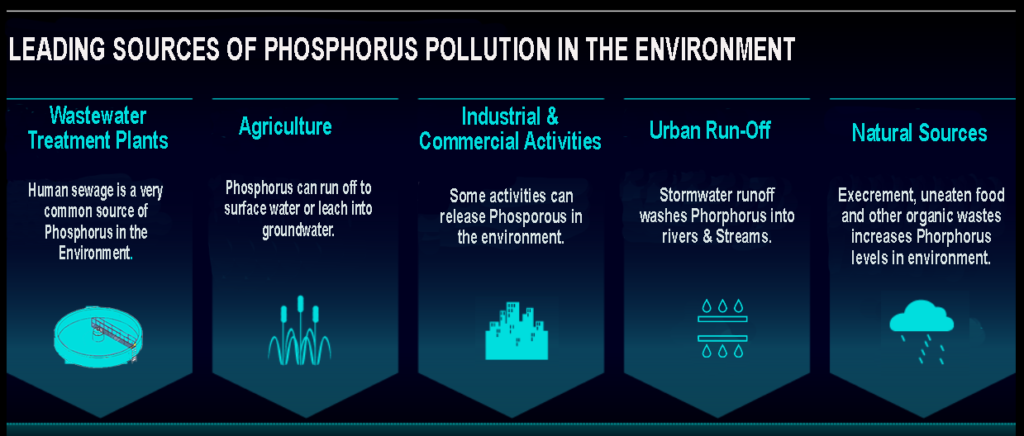
Blog
Phosphorus Recovery from Wastewater
Introduction: The importance of Phosphorus Recovery from Wastewater
Author: Ahmed Bakhiet – Project Manager – Coftec.
In the quest for sustainable water management and environmental stewardship, the focus on nutrient removal and recovery from wastewater has taken center stage. Nutrients, such as phosphorus and nitrogen, are essential for plant growth and ensuring global food security. However, their uncontrolled release into water bodies through wastewater discharge can have a significant impact on the environment and human health.
This blog post delves into the crucial topic of nutrient removal and recovery from wastewater, with a particular emphasis on phosphorus recovery. We will explore the significance of phosphorus removal and its environmental impact, and shed some light on sustainable practices that can mitigate nutrient pollution and create a circular economy where valuable nutrients are reclaimed, repurposed, and reused.
What are the Sources of Phosphorus Pollution?
Phosphorus pollution can come from a variety of sources, including:
- Agriculture: Phosphorus is a major component of fertilizers, and when these fertilizers are applied to agricultural fields, some of the phosphorus can run off into surface water or leach into groundwater.
- Urban runoff: When it rains or snows, phosphorus from streets, parking lots, and other hard surfaces can wash into storm drains and eventually reach waterways.
- Wastewater treatment plants: Wastewater treatment plants are designed to remove phosphorus from wastewater, but some phosphorus can still escape into the environment.
- Industrial and commercial activities: Some industrial and commercial activities, such as the production of fertilizers and detergents, can release phosphorus into the environment.
- Natural sources: Some phosphorus pollution comes from natural sources, such as bird droppings and weathering of rocks.

The relative importance of these different sources of phosphorus pollution varies depending on the location. In some areas, agriculture is the main source of phosphorus pollution, while in other areas, urban runoff or wastewater treatment plants may be more important.
Eutrophication is the process by which a body of water becomes enriched with nutrients, particularly phosphorus and nitrogen.
Environmental Risks of Phosphorus Pollution
Phosphorus is an essential nutrient for plant growth and plays a crucial role in agricultural productivity. However, when it enters water bodies through wastewater discharge, it can lead to a number of harmful effects. These include:
- Harmful algal blooms: When there is too much phosphorus in the water, algae can grow out of control, forming harmful algal blooms. These blooms can produce toxins that can be harmful to fish, other aquatic life, and even humans.
- Deoxygenation: When algae blooms die, they sink to the bottom of the water and decompose. This process uses up oxygen, which can lead to deoxygenation of the water. Deoxygenation can kill fish and other aquatic life, and it can also make the water unsafe for human contact.
- Damage to aquatic ecosystems: Phosphorus pollution can damage aquatic ecosystems by disrupting the food chain and altering the balance of organisms in the water. This can lead to the loss of biodiversity and the degradation of water quality.
Eutrophication is a serious problem that can have a significant impact on the environment and human health. It is important to take steps to reduce phosphorus pollution from wastewater and other sources.
Methods for Removing Phosphorus from Wastewater?
The removal of Phosphorus from wastewater can be performed in a variety of methods such as chemical precipitation, biological treatment, and adsorption.
Chemical Precipitation – the most common chemical removal method and involves dosing metal salts (e.g. ferric chloride, aluminium sulfate, calcium chloride) at certain stages of the treatment process. This can be into pre-treated influent, conventional activated sludge (CAS) reactors or at the outlet from the secondary clarifier. The addition of these chemicals facilitates the formation of insoluble metal phosphate compounds which can then be settled out of wastewater. P effluent concentrations of 1 mg/L can be achieved by conventional gravity settling, whereas stricter effluent standards will generally demand more sophisticated separation techniques.
It’s important to note that the effectiveness of chemical precipitation for phosphorus removal depends on various factors, including the pH of the wastewater, the concentration of phosphorus, and the choice of metal salt used.
While the resulting precipitates may be rich in phosphorous, this method results in the production of large amounts of sludge containing phosphorus, which is challenging to handle and dispose of sustainably. The rates of phosphorus removal are usually directly related to the quantity of chemicals added, which affects the generation of additional solid materials. Extracting chemically-bonded phosphorus from this sludge can also be very challenging. As a result, achieving efficient phosphorus recovery for potential reuse becomes unlikely.
Enhanced Biological Phosphorus Removal (EBPR) – is a biological process that uses specialized bacteria to remove phosphorus from wastewater. The bacteria called polyphosphate-accumulating organisms (PAOs), are able to accumulate phosphorus in their cells in the form of polyphosphates. This phosphorus is then stored in the sludge and can be recovered for reuse.
EBPR is a more efficient and sustainable way to remove phosphorus from wastewater than chemical precipitation. It does not produce any sludge that is rich in phosphorus, and the phosphorus that is removed can be recovered for reuse.
The EBPR process is typically implemented in two stages:
- Anaerobic phase: In the anaerobic phase, the PAOs are exposed to anoxic conditions. This causes them to produce a substance called PHA (polyhydroxyalkanoates), which is a form of stored energy.
- Aerobic phase: In the aerobic phase, the PAOs are exposed to aerobic conditions. This causes them to use the PHA they have stored to produce energy, and the phosphorus that was stored in the PHA is released into the cells. The phosphorus is then stored in the cells in the form of polyphosphates.
The EBPR process is a relatively complex process, but it is a very effective way to remove phosphorus from wastewater. It is also a more sustainable way to remove phosphorus than chemical precipitation, as it does not produce any sludge that is rich in phosphorus.
Here are some of the benefits of EBPR:
- High phosphorus removal efficiency: EBPR can remove phosphorus from wastewater to very low levels, typically below 1 mg/L.
- Sustainable: EBPR does not produce any sludge that is rich in phosphorus, and the phosphorus that is removed can be recovered for reuse.
- Flexible: EBPR can be implemented in a variety of wastewater treatment systems, including conventional activated sludge systems and membrane bioreactor systems.
Overall, EBPR is a very effective and sustainable way to remove phosphorus from wastewater. It is a more complex process than chemical precipitation, but it is worth the investment in terms of the environmental benefits.
Use of Adsorptive Media – Phosphorus (P) can be eliminated from the wastewater using filter media through either sorption or direct precipitation. In simple terms, this process entails the transfer of inorganic P from the wastewater to reactive components (like calcium or iron) present in the media, where it adheres to the surface of the media and accumulates in a targeted manner.
Adsorptive media can be manufactured from natural products (e.g. apatite, bauxite, or limestone), industrial waste products (e.g. fly-ash, ochre, or steel slag), or man-made products (e.g. FiltraliteTM).
Once the media is saturated with phosphorus, it can be regenerated by removing the phosphorus from the media. This can be done by heating the media, which causes the phosphorus to volatilize. The phosphorus can then be collected and reused.
There are some challenges around the use of adsorptive media that need to be addressed, such as the cost of the media and the efficiency of the process. The spent media can also contain high concentrations of phosphorus, which can make it difficult to dispose of.
Despite these challenges, adsorptive media is a promising technology for phosphorus reuse. With careful planning and management, it can be a cost-effective and efficient way to remove phosphorus from wastewater and recover this valuable resource.
Can Phosphorus Recovery Solve the Global Phosphorus Crisis?
To address these challenges, researchers and engineers have been exploring innovative technologies for phosphorus recovery from wastewater. By recovering phosphorus from wastewater, we can create a circular economy where this valuable nutrient is repurposed for agricultural use, reducing our dependence on phosphate rock mining and minimizing the environmental impact of phosphorus pollution.
Cutting-edge technologies such as struvite precipitation, adsorption onto substrates, and enhanced biological phosphorus removal have shown promising results in phosphorus recovery. Struvite precipitation involves the controlled formation of struvite crystals (magnesium ammonium phosphate) through the addition of magnesium and phosphate sources to wastewater. These crystals can then be harvested and processed into high-quality fertilizer.
Phosphorus recovery offers several benefits beyond environmental sustainability. It closes the nutrient loop, minimizing the need for synthetic fertilizers and reducing the risk of nutrient imbalances in agricultural soils. Additionally, by recovering phosphorus from wastewater, we reduce the burden on wastewater treatment plants, enhance treatment efficiency, and save energy.
Conclusion: Partnering for Sustainable Phosphorus Recovery
As we have seen, phosphorus recovery from wastewater is imperative for nutrient recycling, pollution prevention, and sustainable water management. However, practical implementation requires expertise in innovative treatment technologies and integrated solutions.
At Coftec, we are committed to helping businesses and communities transition towards sustainable phosphorus stewardship. As a leading provider of water and wastewater solutions in Ireland, we offer cutting-edge technologies and customized solutions for efficient phosphorus removal and recovery.
Our team of experts can help you evaluate your specific wastewater composition, identify optimal recovery processes, and design tailored treatment systems to extract maximum value from your phosphorus stream. We also provide ongoing operational support to ensure consistent system performance and phosphorus recovery.
To learn more about our sustainable nutrient recovery solutions, get in touch with our water treatment specialists today. We are dedicated to empowering businesses to lead the way towards a circular phosphorus economy. With the right partnership, you can cost-effectively transform wastewater into a renewable and environmentally responsible phosphorus source.
